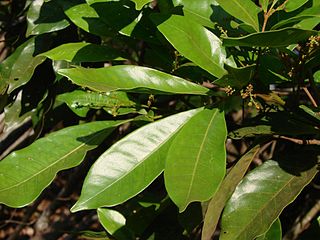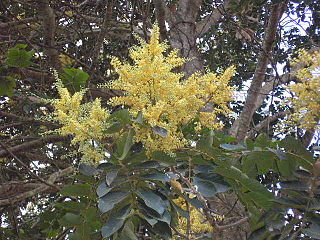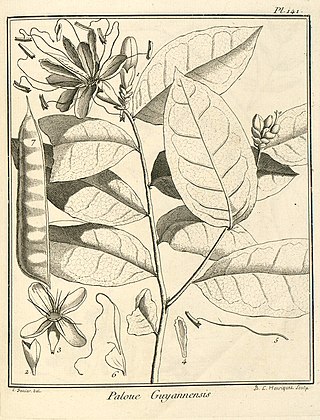
Hevea is a genus of flowering plants in the spurge family, Euphorbiaceae, with about ten members. It is also one of many names used commercially for the wood of the most economically important rubber tree, H. brasiliensis. The genus is native to tropical South America but is widely cultivated in other tropical countries and naturalized in several of them. It was first described in 1775.

Vismia is a genus of flowering plants in the family Hypericaceae. Members of the genus are small trees and shrubs found in tropical and subtropical areas of Central America and South America. Including the countries of Belize, Bolivia, Brazil, Colombia, Costa Rica, Ecuador, El Salvador, French Guiana, Guatemala, Guyana, Honduras, Mexico, Nicaragua, Panamá, Peru, Suriname, Trinidad-Tobago and Venezuela.

Brosimum is a genus of plants in the family Moraceae, native to tropical regions of the Americas.

Tapirira is a genus of flowering plants in the family Anacardiaceae. It includes nine species native to the tropical Americas, ranging from southern Mexico through Central America and northern South America to Bolivia, Paraguay, and southern Brazil.

Dimorphandra is a genus of legume in the family Fabaceae, subfamily Caesalpinioideae. It includes 26 species native to northern South America, ranging from Colombia and Venezuela to Bolivia, Paraguay, and southeastern Brazil.

Swartzia is a genus of flowering plants in the family Fabaceae. It was named in honor of Swedish botanist Olof Swartz and contains about 200 species. Swartzia is restricted in its geographical distribution to the New World Tropics, where it occurs primarily in lowland rainforests, but also in savannas, pre-montane forests, and tropical dry forests. While it can be found throughout the wet lowlands from Mexico and the Caribbean islands to southern Brazil and Bolivia, Swartzia is most abundant and species-rich in Amazonia, where 10–20 species may co-occur at a single site. The species of Swartzia are mostly trees, ranging from small understory treelets to large canopy emergents. Some species, especially in savannas, are mult-stemmed shrubs.

Tachigali is a flowering plant genus in the legume family (Fabaceae). It includes 74 species of trees native to the tropical Americas, ranging from Nicaragua to Bolivia, Paraguay, and southern Brazil. Typical habitats include tropical rain forest, lower montane forest, seasonally-flooded and non-flooded evergreen lowland forest and woodland, gallery and riparian forest, sometimes on white sands, cerrado and other dry woodland, and rocky grassland.

Helicostylis is a genus of flowering plants in the mulberry family, Moraceae. It includes eight species native to the tropical Americas, ranging from Costa Rica to Bolivia and southeastern Brazil.
Naucleopsis is a genus of flowering plants in the mulberry family, Moraceae. It includes 25 species native to the tropical Americas, ranging from Honduras to Bolivia and southeastern Brazil.
Perebea rubra subsp. glabrifolia is a subspecies of flowering plant in the family Moraceae. It is native to Ecuador, Peru, and northern and west-central Brazil.
Pseudolmedia is a flowering plant genus in the mulberry family (Moraceae). Species are found in southern Mexico, the Caribbean, and Meso- and South America. They are known in Latin America as lechechiva and used for timber, construction wood, and sometimes in folk medicine.

Tapura is a genus of plant in the family Dichapetalaceae.

Ficus americana, commonly known as the West Indian laurel fig or Jamaican cherry fig, is a tree in the family Moraceae which is native to the Caribbean, Mexico in the north, through Central and South America south to southern Brazil. It is an introduced species in Florida, USA. The species is variable; the five recognised subspecies were previously placed in a large number of other species.

Paloue is a genus of flowering plants in the family Fabaceae. It belongs to the subfamily Detarioideae. The genera was first created with the description of Paloue guianensis by Aublet in 1775.

Schnella is a genus of flowering plants in the legume family, Fabaceae. It belongs to the subfamily Cercidoideae. All of its species are neotropical lianas.
Moutabea is a genus of flowering plants in the family Polygalaceae with 11 species. It was first described in 1775 by Jean Aublet. Most species are neotropical, ranging from Costa Rica to Bolivia and central Brazil, with one species, M. pacifica, native to New Caledonia.
Maquira is a genus of trees in the family Moraceae, native to South America.
Perebea rubra is a species of plant in the genus Perebea of the family Moraceae. It is a tree native to tropical South America, ranging from southeastern Colombia to Ecuador, Peru, northern and west-central Brazil, Suriname, and French Guiana.

Coussapoa is a genus of flowering plants belonging to the family Urticaceae.













